Location: 43.13 N, 89.28 W
If you are reading this journal entry it means I was able to post it using the satellite phone and not an internet connection. This might sound easy to you, but I had to struggle to get the computer and satellite phone to work properly. Why would I go into all this trouble instead of using the internet if the expedition has not started? Because we do not know if we will have internet access at King George Island. Escudero base will be doing some maintenance work on their internet setup during our expedition, so it is not clear yet if it will be available.
The satellite phone works similarly to a cell phone. Your cell phone beams the information to a nearby cell tower, who relays the signal to another tower, and then another tower, until the cell phone you are calling is found. The satellite phone, as it names indicates, beams the information to a passing communications satellite, and not a tower on Earth. The satellite beams back the signal to a relay station that sends the information to a regular phone system. Our sat phone uses satellites that orbit the Earth at a low altitude (1500 Km or 930 miles). One of the challenges is that we need to have a clear line of sight to one of the many communication satellites orbiting the Earth. This means we probably need to be outdoors and away from buildings. Here is a picture of the setup at the high school when I was testing it for the first time at 18F. I managed to send a short test message to Alaska that said "This is a test" and only took me half an hour.

This setup, albeit very different, reminded me of the 1980's movie character E.T. calling home. We will use this phone for an occasional call to home as well, but it will mostly be used for sending the journals to the PolarTREC offices in Fairbanks, Alaska. Someone there will post them on this website using the internet. We need to practice setting up the equipment so we can troubleshoot here, where we have plenty of resources, and not in Antarctica, where resources will be more limited. I also need to condense the journal entries so they are small enough to be sent through the short connection time that the phone has. The images also need to be compress to a very small size (80 kBytes), and be sent one by one. That explains why these images are smaller than the ones from previous postings. I plan on replacing the small images we send from Antarctica with bigger ones once we get back to the internet world. Here I am, sending this text at 12F while my car is at the shop in Madison..
Si estas leyendo esta entrada en el diario de expedición quiere decir que logré utilizar el teléfono satelital en lugar del internet para mandar el texto y las imágenes. Esto puede sonar a cosa fácil, pero he batallado bastante para que el teléfono y la computadora funcionen adecuadamente. ¿Porqué todo este trabajo en vez de usar internet, si la expedición no ha empezado? Porque no sabemos si tendremos Internet en la Isla Rey Jorge. Se realizarán trabajos de mantenimiento al internet en la estación de investigación Escudero durante el tiempo de la expedición.
El teléfono satelital funciona de la misma manera que tu teléfono celular. Tu celular transmite la señal a la torre celular más cercana. Ésta le envía la información a otra torre, y así se va la señal, de torre en torre, hasta que encuentran el celular al que quieres llamar. El teléfono satelital, como su nombre lo indica, transmite la señal a un satélite de comunicaciones en lugar de una torre de celular. El satélite manda la señal de vuelta a tierra a una estación en la que se pone la información en la línea telefónica normal. Nuestro teléfono usa satélites de baja altitud (1500 km). Uno de las complicaciones es que necesitamos tener una visión directa a uno de los tanto satélites que orbital la tierra. Lo más seguro es que necesitemos estar fuera de los edificios. Acá una foto mientras probaba el sistema en la escuela, a temperatura de -8 C. Logré mandar un correo prueba a Alaska que ponía "esta es una prueba" y sólo me tarde media hora.

Nestor teléfono, aunque diferente, me recordó al personaje de película de los 80's E.T. llamando a casa. Nosotros también usaremos el teléfono para llamar a casa esporádicamente; lo usaremos principalmente para mandar las entradas a la bitácora, como ahora, a las oficinas de PolarTREC en Fairbanks, Alaska. Allá, alguien se encargará de subirlas a la red mediante el internet. Necesitamos practicar el montaje del equipo para resolver cualquier problema potencial acá, donde tenemos muchos recursos, y no en la Antártica, en donde tendremos menos recursos. Necesito condensar el textos y las imágenes (máximo 80 Kbytes) para que se puedan mandar en el limitado tiempo de conexión satelital. Esto explica porque las imágenes en esta entrada son de menor tamaño que las de las entradas anteriores. Planeo reemplazar las imágenes que envíe desde la Antártida por unas mayores en cuanto lleguemos a territorio internet. Acá estoy, mandando este texto e imágenes mientras mi coche está en el taller acá en Madison. Estoy a -11 C.


Comments